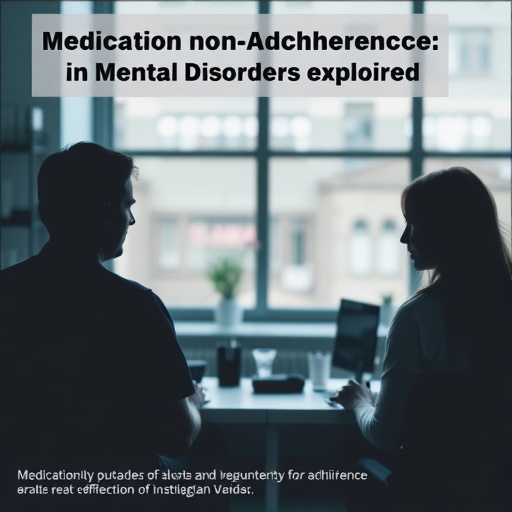In a compelling new meta-analysis published in BMC Psychiatry, researchers have uncovered the staggering prevalence and complex predictors of non-adherence to psychotropic medications among patients suffering from mental disorders in resource-limited settings. This comprehensive study, which synthesized data from 23 observational studies incorporating over 23,000 individuals, exposes the significant challenges that undermine effective pharmacotherapy in mental health—a sector often marginalized, especially in low-resource life trajectories. Its findings not only quantify the scope of medication non-adherence but also offer critical insights to inform future mental health policies and clinical interventions across diverse socioeconomic landscapes.
Adherence to prescribed psychotropic medications is a cornerstone of effective treatment regimens for mental disorders, directly influencing symptom management, relapse prevention, and quality of life. Despite its clinical importance, adherence remains a frequently neglected variable within mental health care, particularly in economically disadvantaged populations. The systematic review and meta-analysis embarked on by Zewdu and colleagues, following rigorous protocols as stipulated by Cochrane and PRISMA guidelines, fills an essential gap. It extensively examined the magnitude of non-adherence and delineated its multifactorial predictors, thereby framing this issue within the complex interplay of sociocultural, patient-centered, and pharmacological influences.
The findings reveal an alarming pooled prevalence of psychotropic medication non-adherence at 46%, implying that nearly half of patients with mental disorders in these settings fail to follow their prescribed treatment regimens reliably. Such a high rate underscores systemic challenges and individual barriers that thwart therapeutic effectiveness. Intriguingly, patients diagnosed with major depressive disorder exhibited a notably high non-adherence rate, surpassing 40%, a statistic that heightens concerns particularly due to depression’s pervasive global burden and its impact on everyday functioning.
Diving deeper into the determinants, the study highlights sociodemographic factors as significant predictors, including variables that typically encompass age, gender, education, and socioeconomic status. These elements collectively contributed to a 58% increase in the odds of non-adherence, indicating that broader social determinants play a pivotal role in shaping medication-taking behaviors. The heterogeneity of this association also reflects the diversity of populations studied, suggesting culturally nuanced and environment-specific adherence challenges.
Remarkably, patient-related factors like motivation, illness perception, and cognitive variables were associated with a 47% increased likelihood of non-adherence. Such findings echo psychological models of health behavior, reaffirming the critical role of individual insight and attitudes in chronic disease management. Lack of insight, in particular, a state where patients fail to recognize the need for treatment, was linked with a 24% increased propensity for non-adherence, highlighting a psychiatric self-awareness deficit that complicates therapeutic engagement.
Equally important were emotional and social dimensions. Negative attitudes toward treatment, ranging from skepticism about medication efficacy to fears of side effects, doubled the odds of non-adherence. Poor social support structures, often characterized by isolation or stigma within families and communities, similarly amplified the risk, reinforcing the concept that mental health interventions require more than biomedical solutions—they demand holistic social integration strategies.
Social stigma, particularly self-stigma wherein individuals internalize societal prejudices, emerged as one of the most potent predictors, with nearly a twofold increase in non-adherence probability. This psychological barrier often engenders feelings of shame and hopelessness that can erode treatment motivation. In resource-poor contexts, where mental health literacy remains limited and stigma pervasive, these findings emphasize the urgent need for community-level stigma reduction programs.
Drug-related factors, including complex dosing schedules, adverse side effects, or medication availability issues, were also significantly associated with non-adherence, highlighting systemic weaknesses such as inconsistent drug supply chains and suboptimal pharmaceutical care services. This structural perspective is crucial in understanding adherence as not merely a patient problem but a health system challenge demanding policy-level interventions.
One of the more counterintuitive discoveries was the identification of substance use as a protective factor against medication non-adherence, associated with a 16% decreased risk. This paradoxical result invites further exploration: possible explanations might include increased contact with healthcare due to substance-related issues or the use of substances as self-medication parallel to prescribed regimens, although implications demand cautious interpretation due to extreme heterogeneity in this finding.
Despite the robust methodology underpinning this meta-analysis, the authors advise cautious interpretation of their results. The significant heterogeneity across studies—reflected in statistical measures such as high I² values—indicates varied adherence definitions, assessment methods, and patient populations, which limits the generalizability of the findings. Moreover, the predominance of cross-sectional study designs precludes causal inference and points to the necessity for prospective longitudinal research to unravel temporal relationships.
This comprehensive synthesis of global data delivers powerful evidence that medication non-adherence among psychiatric populations in resource-limited settings is a multifaceted crisis demanding urgent attention. For policymakers, these findings are a clarion call to foster integrated mental health strategies emphasizing psychoeducation, social support enhancement, stigma mitigation, and structural health system improvements. Tailored interventions that address the identified predictors could markedly improve adherence rates, thereby enhancing patient outcomes in chronic mental illnesses.
Ultimately, the study by Zewdu et al. underscores the intrinsic complexity of mental healthcare delivery within resource-constrained environments. It provides a vital empirical foundation to rethink pharmacotherapy management, emphasizing that therapeutic success hinges on overcoming intricate interdependencies involving social context, individual psychology, and systemic infrastructure. Future investigations armed with longitudinal and interventional designs will be instrumental in charting effective pathways to reduce the global burden of non-adherence in mental disorders.
Subject of Research:
Psychotropic medication non-adherence and its predictors among patients with mental disorders in resource-limited settings.
Article Title:
Non-adherence level of pharmacotherapy and its predictors among mental disorders in a resource-limited life trajectories: a systematic review and meta-analysis
Article References:
Zewdu, W.S., Dagnew, S.B., Tarekegn, G.Y. et al. Non-adherence level of pharmacotherapy and its predictors among mental disorders in a resource-limited life trajectories: a systematic review and meta-analysis. BMC Psychiatry 25, 512 (2025). https://doi.org/10.1186/s12888-025-06838-9
Image Credits: AI Generated




